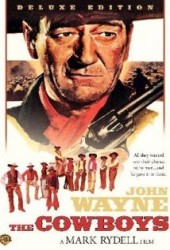 The Cowboys:
The Cowboys:
A Success Story
Warner Brothers Studios
Press Release, fall 1971

William Dale Jennings’ novel “The Cowboys” is a rarity in today’s publishing world. In a time of sensationalism in books, Jennings’ warm, sometimes funny, sometimes sad, and always absorbing story of a dozen youngsters in 1878 making their first cattle drive and ending it as men, is not only causing talk, it is selling books.
In the stores less than a month, “The Cowboys” is going into its third printing. Playboy’s new and prestigious Playboy Book Club has chosen “The Cowboys” as their special Midwinter selection and the Warner Bros. movie, produced and directed by Mark Rydell, one of Hollywood’s brightest young film makers, will be released in January premiering at New York’s famed Radio City Music Hall.
Jennings, formerly a documentary film maker with one other novel, “The Ronin,” an unusual story of a 12th century Samurai, to his credit, has always been intrigued by Western lore. He says that the spark which led to the writing of “The Cowboys” was when he ran across the fact that cowboys were, in the old West, indeed little boys of 11, 12 or 13, who had to work when the older cowmen were, off in times of war, or as in his story, the Gold Rush.
When Mark Rydell read the original manuscript, it only took him 20 pages to decide that he had to make the film. Publishers Stein and Day quickly decided to bring out the hard cover and Bantam will publish the paperback.
Storyline
 “The Cowboys” is western in locale only. The action includes much of the violence of the West of the 1870’s but the story itself deals with that natural estrangement of adults and youngsters becoming adults.
“The Cowboys” is western in locale only. The action includes much of the violence of the West of the 1870’s but the story itself deals with that natural estrangement of adults and youngsters becoming adults.
Wil Anderson is forced to hire a dozen boys between 11 and 15 for his last big drive. As indicated by the term “cowboys” and opposed to “cowmen,” the hiring of boys this young isn’t unusual, but hiring only boys this young fills Wil with terrible doubts. They are going through 400 miles of the most dangerous wilderness in the West. They’ll be threatened with every disaster from broken necks riding half-broken horses to storms and stampedes, hostile Indians and rustlers. His decision on the way to face these threats is characteristic. He’ll run the drive with an iron hand and crush the boyhood out of these green kids.
He is successful at a terrible cost. As he comes to respect and admire, and finally love them as sons, they gradually learn to hate him as a heartless tyrant. Each boy comes to the point where he wants to kill Wil Anderson. Only the presence of the black chuck-master, Charlie Nightlinger, restrains them.
But even Charlie’s wisdom is of no use when catastrophe strikes the drive and the boys are left to make all of their decisions alone. In the blood-curdling climax., the story-teller unflinchingly describes the passions of youth., the uses of age and the magnificently heart-breaking adventure called life.

